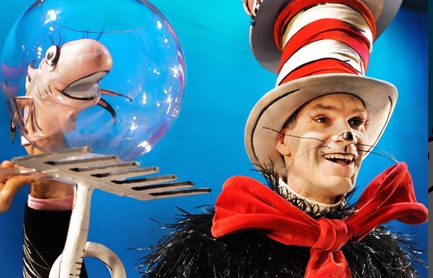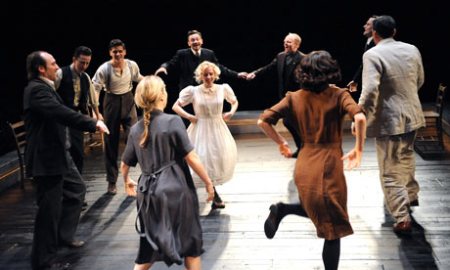The Cottesloe Theatre is steadily becoming one of those spaces that I admire. It has a life of its own, despite being part of the National Theatre. Some people will frown upon the work that comes into it, for it is bold, challenging and often gambling with new work that is a far cry from the NT brand of entertainment for the people. The Cottesloe Theatre for me is almost restoring my faith in the work of the National Theatre, proving at times it can dance the thin line of experiementation and throw caution to the wind at it’s faithful audiences.
Really Old, Like Forty Five is one of those pieces that the National has put their faith in – with a big risk. It is an absurd new play by Tamsin Oglesby, charting the lives of a family as they plod through old age and dementia. This might seem like a conventional play on the surface, but when you throw in a medical company whose aim is to rid the streets of old people, facilitating uthensia and attempting to cure memory loss with the use of a robot nurse that has animastic qualities, you begin to see what an absurd play this really is.
Here lies the problem. This mix of robotic nurses, dementia curing pills, and a focus on a family attempting to fight through memory loss is possibly a little far fetched to comprehend. Or maybe it is novel approach to a hard topic? Either way there is no escaping the fact that this play is absurd, and this of course means that either you will love it, or hate it.
I couldn’t help but to feel Really Old, Like Forty Five is a mix of a Doctor Who episode with characters from The Catherine Tate Show attempting to pull off a NHS advert for dementia.
Oglesby’s play juxtaposes the medical trials against that of the real life, and if you can look beyond the surreal aspects of the play – there is a message that rings loud and clear. At what age do we get old? When is it time to stop pretending we are young?… and how far do the medical trials of new treatments go in order to gain reputation or profit?
Anna Mackin certainly faces the play with a great force in her direction. She tackles the subject matter straight on, switching the action between the various themes and directions of the text effortlessly so that there isn’t a moment for the audience to get lost on the tangent. Her insight into the play even allows her for some slightly surreal moments involving the use of Liz Brotherston’s stage design and video work by Fifty Nine Productions Ltd, which take form of a giant tortoise and a baby flying through the air. Odd aye?
Whilst the play may take an unusual approach to getting a point across, there is no denying that this dark comedy does feature some superb acting from the cast. Judy Parfitt as the steady dementia form of old woman Lyn is one of the key figures in Really Old, Like Forty Five. She shows a harrowing display of emotion during scenes where she believes things that aren’t true because her memory is failing her. Equally her inability to understand what is going on, makes for brilliant one liners allowing for the comedy to arise.
The Olivier Awarded Marcia Warren as the dotty Alice brings such a charm and wit to her acting capturing the heart of growing old and still managing to survive with vigor. Oglesby’s portrayal of these older women are at times immensely sad, yet glowing with warmth and joy. Michela Meazza as Mimi the robotic nurse is beautiful. She moves with such robotic and structured manners that when combined with the sound effects, I quite simply forgot she was even human (is that possible?).
The rest of the cast featuring Lucy May Barker, Paul Bazely, Tanya Franks, Gawn Grainger, Thomas Jordan and Paul Ritter each bring with them the absurd characters of Oglesby’s play to different ends, but still achieving the desired affects.
Really Old, Like Forty Five is a tough play to comprehend. Oglesby’s setting of the play at times outweighs the subject matter of growing old and dementia – yet equally she has managed to create a common worry within the everyday person and completely turn it on it’s head. We often see in the media the use of clinical trials for various drugs, and countless times we have heard of courtroom trials around uthensia, Really Old, Like Forty Five tackles these subjects in an absurd manner. Often hitting the theme with poignant emotion, other times slightly missing the point by the very nature of the play.
The outcome is really down to the spectator. If you’re a regular at the National Theatre, I might suspect that you have a certain idea of what to expect from the play. Well – you won’t quite see what you expected. Really Old, Like Forty Five is a compelling approach to dramatising the worries that we all have, but to be sure – watch some Doctor Who episodes before you go, just to get into the spirit of it!
Really Old, Like Forty Five is playing in the Cottesloe Theatre at the National Theatre until 20th April 2010. Booking in person, over the phone or indeed as always through the National Theatre’s website.






 Posted by Jakeyo
Posted by Jakeyo 









 There is something oddly familiar with Alan Bennett’s new play, The Habit of Art now playing at the National Theatre. It has nothing to do with Artistic Director Nicholas Hytner, directing another of Bennett’s plays, the last being The History Boys at the National again. It has nothing to do with the subject matter either, a look into the relationship and lives of W H Auden and Benjamin Britten.
There is something oddly familiar with Alan Bennett’s new play, The Habit of Art now playing at the National Theatre. It has nothing to do with Artistic Director Nicholas Hytner, directing another of Bennett’s plays, the last being The History Boys at the National again. It has nothing to do with the subject matter either, a look into the relationship and lives of W H Auden and Benjamin Britten.